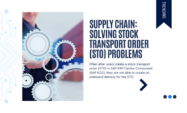SAP Inventory Management
Filter By
Browse By
- SAP Analytics and AI
- SAP Application Development and Integration
- All SAP Application Development and Integration
- SAP ABAP
- SAP ABAP Development Tools
- SAP ABAP Test Cockpit
- SAP API Management
- SAP BAPI
- SAP Basis
- SAP BRF
- SAP Business Application Studio
- SAP CMS
- SAP Design Studio
- SAP Development Tools
- SAP DevOps
- SAP EAI
- SAP EDI
- SAP Extension Suite
- SAP Fiori
- SAP Fiori Elements
- SAP Integration Suite
- SAP Low Code Application Development
- SAP Low Code Automation
- SAP Netweaver
- SAP Release Management
- SAP UI5
- SAP Web Application Server
- SAP Web IDE
- SAP Business Process Management
- SAP Center of Excellence
- SAP CIO
- SAP Customer Experience
- SAP Data and Data Management
- All SAP Data and Data Management
- SAP BW
- SAP BW/4HANA
- SAP Crystal Reporting
- SAP Data Archiving
- SAP Data Center
- SAP Data Governance
- SAP Data Integration
- SAP Data Migration
- SAP Data Quality
- SAP Data Services
- SAP Data Strategy
- SAP Data Visualization
- SAP Data Warehouse Cloud
- SAP DMS
- SAP Document Control
- SAP EIM
- SAP ETL
- SAP ETL Tools
- SAP HANA
- SAP HANA Administration
- SAP HANA Deployment Infrastructure
- SAP HANA Studio
- SAP Master Data
- SAP Master Data Governance
- SAP MDM
- SAP Enterprise Architect
- SAP Enterprise Asset Management
- SAP ERP
- SAP Finance
- All SAP Finance
- SAP Accounting
- SAP AR AP
- SAP Asset Accounting
- SAP Billing Systems
- SAP BPC
- SAP BRIM
- SAP Cash Management
- SAP Central Finance
- SAP Controlling
- SAP COPA
- SAP Cost Center Accounting
- SAP e-invoicing
- SAP FICO
- SAP Finance Automation
- SAP Financial Closing Cockpit
- SAP Financial Consolidation
- SAP Financial Planning
- SAP FX Risk
- SAP General Ledger
- SAP Global Tax Management
- SAP Hyperion
- SAP Order to Cash
- SAP Payment Processing
- SAP Profitability Analysis
- SAP Rebate Management
- SAP S/4HANA Finance
- SAP Universal Journal
- SAP Governance Risk and Compliance
- SAP Human Capital Management
- SAP Intelligent Technologies
- SAP Platform and Technology
- All SAP Platform and Technology
- SAP Business Technology Platform
- SAP Cloud Connector
- SAP Cloud Integration Platform
- SAP Cloud Migration
- SAP Cloud Platform
- SAP Cloud Providers
- SAP Cloud Strategy
- SAP Container Platform
- SAP Digital Asset Management
- SAP Digital Integration Hub
- SAP Digital Signature
- SAP HANA Enterprise Cloud
- SAP HEC
- SAP Hyperscalers
- SAP Infrastructure
- SAP Messaging
- SAP Smart Forms
- SAP Quality and Testing
- SAP Security
- SAP Spend Management
- SAP Supply Chain Management
- All SAP Supply Chain Management
- SAP APO
- SAP Asset Management
- SAP Business Network
- SAP Digital Manufacturing Cloud
- SAP Digital Twin
- SAP EWM
- SAP IBP
- SAP Inventory Management
- SAP Label Printing
- SAP Logistics
- SAP Manufacturing
- SAP Manufacturing Automation
- SAP MES
- SAP MII
- SAP MM
- SAP MRO
- SAP MRP
- SAP Order Management
- SAP Plant Maintenance
- SAP PLM
- SAP Production Planning
- SAP S&OP
- SAP SD
- SAP SPM
- SAP Supply Chain Planning
- SAP Track and Trace
- SAP Transportation Management
- SAP System Administration
Supply Chain Management: SAP Inventory Management
Inventory is a fundamental part of your business. Without proper inventory management, the organization can suffer inefficiencies, profit decline, and sustainability impacts.
What is Inventory Management?
Inventory Management is the practice of controlling inventory flow for maximum organizational efficiency. It is suitable for businesses of any size and focuses on organizing and streamlining product storage and fulfillment. The management of stock can be done on a quantity or value basis. Inventory management in SAP is an important component of the Material Management (MM) module, it deals with stocks and goods movement.
With SAP, many companies have real-time data on inventories, which is vital for capacity management and expansion of complex supply chains. The application provides several management tools to help users create an organized warehousing space while uncovering valuable operational data. A couple of examples include the following.
Supply Chain Management: SAP Inventory Management
Inventory is a fundamental part of your business. Without proper inventory management, the organization can suffer inefficiencies, profit decline, and sustainability impacts.
What is Inventory Management?
Inventory Management is the practice of controlling inventory flow for maximum organizational efficiency. It is suitable for businesses of any size and focuses on organizing and streamlining product storage and fulfillment. The management of stock can be done on a quantity or value basis. Inventory management in SAP is an important component of the Material Management (MM) module, it deals with stocks and goods movement.
With SAP, many companies have real-time data on inventories, which is vital for capacity management and expansion of complex supply chains. The application provides several management tools to help users create an organized warehousing space while uncovering valuable operational data. A couple of examples include the following.
Physical locations or organizational levels:
- Plant: A high-level physical location to which the materials are assigned.
- Storage Location: A specific area within the plant where the material is stored.
Four primary movement of goods are:
- Goods Receipt: Inventory can be approved for immediate use or be checked in.
- Goods Issue: A company may choose to process inventories for production or to sell to customers.
- Return Delivery: When materials are being returned from a customer or vendor.
- Internal Movements: When inventory is transferred internally from one location to another.
Most importantly, proper inventory management allows you to move goods with as little wasted time and money as possible. It can help you to optimize demand fulfillment for e-commerce, which is quickly becoming the norm in business to business today.
Benefits of SAP inventory management are:
- Accuracy and timeliness
- Realistic production schedule
- Quality checking
- Inventory analysis
- Proper reporting.
Technical resource partners for consideration might be –Movilitas, Opsveda, SAP.
Further insights for SAPinsiders around SAP Inventory Management
- Real Time Inventory and Order Visibility: Key for Successful Supply Chain Management. Probodh Chiplunkar from Ithena Technologies, outlines how real-time inventory transparency within a technological landscape affects business operations.
- Pick and Choose: How Kingston General Hospital Manages its Inventory with SAP. Author Davin Wilfrid interviews Derrick Morey at Kingston General Hospital (KGH), about the complex network of systems and people managing all the tubes, bandages, needles, and other medical supplies distributed throughout KGH. As an early adopter of SAP ERP technology, the hospital adopted a centralized inventory management system to track supplies for better accuracy.
- Next-Generation Inventory Management. Tom Chason addresses questions about the SAP Enterprise Inventory and Service-Level Optimization and SmartOps solutions. See how an integrated approach offers a powerful way to meet all these requirements for modern supply chains.
1106 results
-

CNH Industrial Cultivates Automated Account Reconciliation Landscape
Published: 20/July/2017
Reading time: 10 mins
CNH Industrial, a global capital goods corporation specializing in the manufacture of agricultural and construction equipment, along with commercial vehicles and powertrain solutions, takes pride in designing and producing machines that “keep agriculture and industry growing.” But with more than 63,000 employees, 64 manufacturing plants, and 50 research and development centers, managing financial tasks is…
-

Grupo TDM Moves to the Cloud with SAP HANA and Delivers Faster and More Efficient Service to Customers
Published: 27/December/2017
Reading time: 10 mins
Grupo TDM wanted to replace its home-grown IT infrastructure with scalable, flexible software hosted on a cloud platform and deliver faster and more efficient service to its customers. Learn how the company implemented SAP HANA running on IBM Cloud for SAP applications to achieve fewer manual, error-prone, paper-based processes; 50% faster information access, providing more…
-

Introduction: Unlocking The Value of Your Enterprise Data to Accelerate Business Transformation
Published: 06/December/2016
Reading time: 2 mins
We frequently hear the words “Digital” and “Transformation” these days. What is it really, in the context of your business? Let’s explore what has been happening in the world around us: True Story #1 – One of the largest sporting events in United States, powered by Hitachi True Story #2 – One of the most complex…
-
-

Supply Chain: Solving Stock Transport Order (STO) Problems
Published: 16/May/2018
Reading time: 12 mins
A common challenge experienced by users in the supply chain functions of a business who create stock transport orders (STO) in SAP ERP Central Component (SAP ECC) is that once they have done so, they are not able to create an outbound delivery for the STO. These problems are common to all types of STO…
-

How SAP Uses Emerging Technologies to Help Its Customers Realize Their Dreams
Published: 28/November/2018
Reading time: 11 mins
Q: You’ve had a lot of roles within SAP. Could you tell us a little bit about your path to your current role within SAP? A: I have always been curious and wanted to understand how companies run. And what better way to do that than to join the world’s largest enterprise software provider and…
-

Understanding the Case for SAP S/4HANA Cloud
Published: 11/February/2019
Reading time: 4 mins
For many organizations, the path to modernization is paved by the cloud. The cloud offers a host of benefits, including rapid implementation, flexibility, scalability, lower maintenance costs, easier regulatory compliance, and access to technologies such as the Internet of Things. With SAP S/4HANA Cloud, SAP customers can take advantage of these benefits in their own…
-

Points to Consider on Your Supply Chain Digitization Journey
Published: 14/February/2019
Reading time: 4 mins
For years supply chain management has involved a series of processes completed in disparate legacy systems. In today’s hyper-competitive digital business world, however, enterprises face challenges rising from customers’ demand for more customized products via varied channels and with faster delivery times. To meet this demand, enterprises need better collaboration and communication with their suppliers,…
-
-

Taking Ecommerce to the Next Level
Published: 01/January/2016
Reading time: 5 mins
With omnichannel options on the rise and a sophisticated ecommerce clientele demanding a seamless web-based purchasing experience, companies are under pressure to deliver a robust ecommerce platform that supports new and existing selling channels. This article takes an in-depth look at how companies can drive innovation by integrating their back-end systems with an ecommerce platform…
-

How SAP Software Can Be a Catalyst for Change
Published: 04/January/2016
Reading time: 5 mins
As the modern supply chain grows in diversity, how can companies tackle this complexity while becoming more mature to meet today’s supply chain challenges? Read this article to learn how to strategically use SAP technology as a catalyst for change and move the business toward an integrated supply chain. Discover the four key principles to…
-

Take the Complexity and Risk Out of Intercompany Transactions
Published: 06/January/2016
Reading time: 4 mins
Companies that operate multiple ERP systems and have international operations continue to be challenged with monitoring cross-entity and intercompany transactions. The risks of waiting to see discrepancies in intercompany billing until month-end close are substantial, ranging from inventory write-offs, top-side adjustments, wasted resources, and financial integrity risk, to major financial exposure. Discover how to simplify…
Become a Member
Unlimited access to thousands of resources for SAP-specific expertise that can only be found here.
Upcoming Events
-

Mastering SAP Collaborate an SAP TechEd on Tour event
November 12 - 14, 2025
Sydney, New South Wales
Australia
View Event
Related Vendors
Your request has been successfully sent

